
newspapers : 1962
| home | catalogue | history | references | appendix |
 |
surfresearch.com.au
newspapers : 1962 |
|
|
|
|
|
| The Australian
Women's Weekly 24 January 1962, page 7. HIS AND HERS.
Surf-board
pants in colorful
cotton.
Kerry Yates, of Bondi, and Mr. Ron Adler, of Clovelly,
wear them for surf-board riding -
Kerry's with a matching top.
Trove 1962 'SOMETHING FFERENT....', The Australian Women's Weekly (1933 - 1982), 24 January, p. 7. (Teenagers' Weekly), viewed 08 Sep 2016 http://nla.gov.au/nla.news-article41853263 |
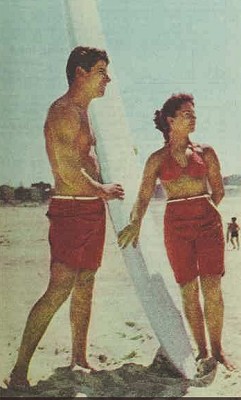 |
HIS FILMS ARE ALL SPLASH HITS
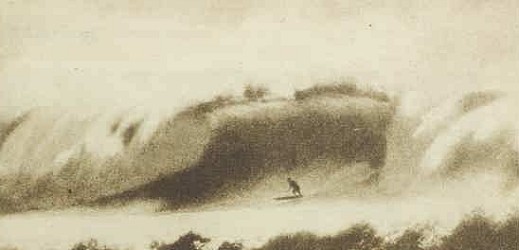
By KERRY YATES
| Bruce brought
his three full-length surfing movies to Australia.
Titled "Slippery When Wet," "Barefoot Adventure," and "Surf Crazy," they were filmed in the surfs of California, Mexico, and Hawaii. Each movie runs for an hour and a half and shows the thrills and skills of surfboard-riding. Bruce commentates from the stage during the color films, telling who's riding the waves and all about the beaches on the screen. "This gives it a personal touch," he said, "'and I can adapt different styles for different audiences." The background music to the films, which seems to capture the sound of the sea, was composed and played by Bud Shank, a popular American jazz musician. A big band backs Shank. |
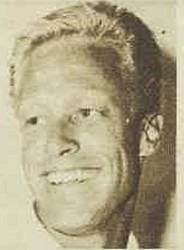 Bruce Brown-producer. |
| Since then
Bruce has produced his three full-length movies and
"about half a dozen short surfing films for television."
With his films he has toured the islands of Hawaii, most of California, and eastern U.S.A. During his tour of eastern Australia (the tour, in January, was his first visit here), Bruce was thrilled with the enthusiasm of the surfboard-riders, mostly teenagers. He filmed most of his new full-length movie, to be released some time this year, at surfing beaches along the coast of N.S.W. Although the films show many local riders from the different beaches, Bruce usually takes a couple of champion surfboard-riders with him to appear in the films. A top surfboard-riding star, Phil Edwards, of Oceanside, California, toured Australia with Bruce. Phil, 23, nil and rugged, is a surfboard and sailing-boat builder by trade and has his own company in the U.S. |
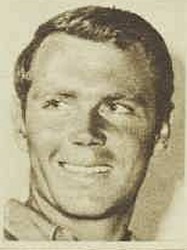 Phil
Edwards-star
|
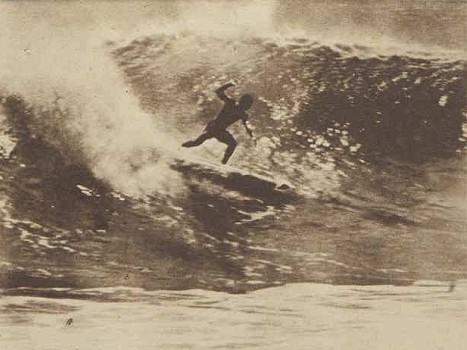 |
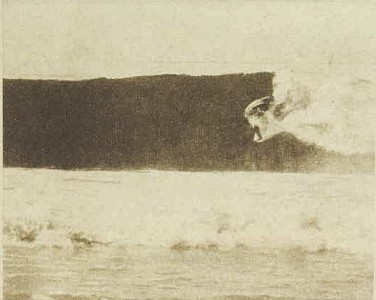 |
| The Australian Womens' Weekly
Wednesday 22 August 1962, Teenagers' Weekly (Supplement) cover Cover image contributed by John Witzig, with many thanks, May 2011. Our cover boys are some of the surfboard riders who competed at Narrabeen, one of Sydney's northern beaches, during the rally organised by the South Pacific Surf Riders Club last season. ( -page 41). Cover
story: John
noted that Midget Farrelly is kneeling in the centre
of the photograph. Note
that most of the boards, probably early foam, are
coloured and decals are impossible to identify.
While
most wear long legged boardshorts, several are in
nylon briefs.
|
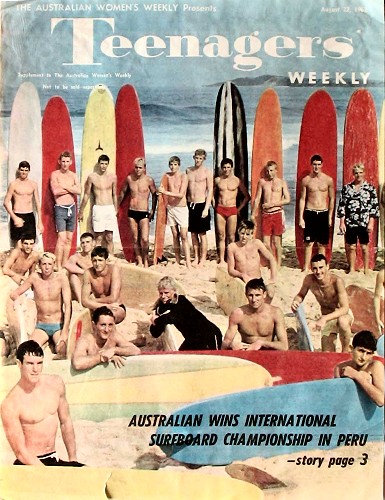 |
"Just had a
call from John Knobel, Bondi local in the 50s and 60s.
That’s him
standing second from the left in front of the red balsa
malibu, wearing his home-made blue board shorts with a snazzy
rope belt.
John surfed on
a Norm Casey hollow 16 foot toothpick before the malibus
arrived in Sydney in 1956 although he was never part of the
lifesaving scene.
As a youngster
he wheeled his board the few blocks to the beach on a hand
cart made from a packing case.
The switch to
light-weight balsa in the late 50s was an amazing break
through because “they could be thrown about from the tail” and
unlike the old longboards were thrilling to ride.
It was also
pretty clear that shorter boards meant more fun in the surf,
so his early boards were under 9 foot.
John also
recalled hopping over the back wall into the lifesavers’
change rooms at Bondi to rescue surfboards impounded by the
likes of Aub Laidlaw.
Peter Bowes added in some names..
Top row left – Denis Lindsay| Page 3 By Kerry Yates BOB PIKE riding one of the
great Hawaiian waves during last summer's
international championships. |
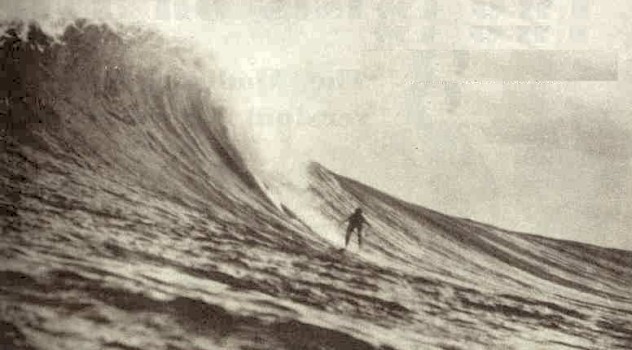 |
BOB, now
22, won the championship last March in competition with the
best from Hawaii, California, France, and Peru, and he made
such a hit with the people of Lima that they asked him to
come back next March - all expenses paid.
An old boy of The King's School, Sydney, Bob's home is at
Manly, just north of Sydney Heads.
The first
Australian to win a surf championship overseas, he was a
member of the 20 strong Australian team which competed in
the International Surfing Championships at Makaha Beach,
Hawaii, last summer.
Because he injured a leg he had to drop out before the
finals.
Several
members of the team qualified, but had to return home before
the finals, delayed by lack of a suitable surf, were held.
Bob, however, got a lucky break soon after the Hawaiian
championships were over.
John
Severson, a champion Californian rider who was visiting
Hawaii for the surfing titles, offered Bob a trip to Peru.
The editor of the American magazine "The Surfer," John won
all the board-riding events in last year's Peruvian
championships and, before he left, the organisers asked him
to arrange for Australian, Hawaiian, and Californian riders
to compete in their 1962 championships.
John chose Bob and a Sydney friend, Mike Hickey, of Bilgola
(another northern Sydney beach), to represent Australia.
It was all
a great surprise to Bob.
"I didn't
even know they surfed in Peru, but what a way to find out!"
he said.
So off he went to California, where he joined two other boys
heading for Peru, and they all drove down to Mexico with
their surfboards tied to the roof of the car.
Taking a couple of weeks for the trip, the boys stopped to
surf at all the famous beaches along America's west coast.
From Mexico they took a plane to Lima, capital of Peru,
where they were put up at the best hotel, as guests of the
city's Waikiki Surf Club.
During their month's stay the visiting surfers went to a
party as guests of the President of Peru and were lavishly
entertained by the city's citizens.
| "There are several beautiful beaches
near Lima," Bob said, "but the surf is small. "The biggest waves are about 10ft. high, and a permanent off-shore wind makes the water too choppy for really good surfing. "But Peru itself, and the people! They're terrific." For winning the international exhibition board-riding event, Bob was awarded a bronze carving of two seagulls mounted on a marble base. The trophy weighs 361b. and is valued at £150.Bob said that all the visiting surfers received "royal" treatment. Holding the bronze seagull trophy he won in the Peruvian Championship while John Severson is presented with his cup for second place. |
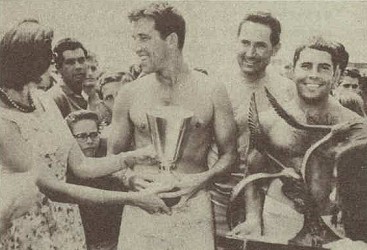 |
Servants employed by the Waikiki Surf Club took charge of their surfboards, rubbed them down with paraffin wax. carried them to the water's edge, and even waited to carry them back after Bob and the other boys had finishing riding.
The servants handed them towels after they showered in the surf club, and even rubbed suntan lotion on their noses before they went out in the sun again.
After
leaving school at 15, Bob did a two-year course at Sydney
Technical College to become a qualified woolclasser.
He worked in
shearing sheds in N.S.W. and Queensland to save the £600 for
the trip to Hawaii.
During that time he visited every surf beach in the eastern
States.
"Fairy
Bower, about a mile off Manly Beach, is THE spot in
Australia when the waves are on," he says.
"The surf in Hawaii, however, is even better-j ust like I'd
always imagined.
But it is very different from ours.
"Waikiki Beach is similar to many Australian beaches- and not so good.
''But for
the keen surfboard rider other Hawaiian beaches have the
perfect waves.
These
beaches - Makaha, Sunset, Alamoana, and the Banzai Pipeline
- have the best surf in the world.
''The waves, building up to heights of 15 to 25ft. and then
dumping on the shore, are very exciting to ride.
"And the
greatest thrill of all is the Banzai Pipeline.
"This is an area where the waves, often reaching 25ft., curl
over at the top to form a 'pipe' before dumping on a rocky
shelf of jagged coral.
"And this was the place that put me out of the Hawaiian
championships.
"I lost my
board going down the Pipeline, but got out of it with a few
scratches and an injured leg.
My board,
however, was wrecked.
All the
front was bashed in and the fin was snapped off."
| The Australian
Womens' Weekly Wednesday 22 October 1962, Teenagers' Weekly (Supplement), page 47S. BY KERRY YATES This summer
thousands of Australian teenagers will be
going surfboard-riding. So if you're a
sandie who dreams of riding an elephant gun
out the back, waiting to beach a boomer
without going down the mine, |
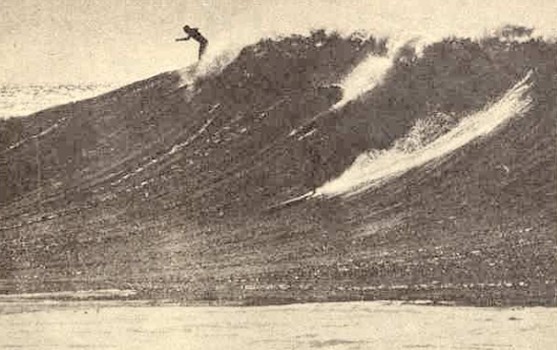 |
ANGLE: Direction a
surfboard travels across a wave, for example, left
angle.
BAGGIES: Baggy pants worn
over swimsuits when riding a surfboard.
BEACH BUM: A boy who
doesn't work or go to school, just hangs around the
beach all day and surfs.
BEACH A WAVE: To ride the
same wave all the way to the beach.
BIG SETS: Groups of extra
big waves, breaking and rolling in one after the
other.
BIG W: Dramatic fall off a
surfboard.
BLASTER: A big wave.
BLEACHIE: Surboard-rider
who bleaches his hair.
BOARD SHORTS: Pants worn
for riding surfboards. .
BOARD WAGGON: Car used for
transporting surfboards from beach to beach.
BOATIES: Members of a surf
club boat crew.
BODGIES: Lumps on knees
and feet caused by constant surfboard-riding.
BODY SHOOTING: Riding a
wave without a board.
BOMBIE: Short for bombora,
where waves break over a reef of rocks just below the
surface.
BOOMER: Big wave.
"BOWER" BOYS: Name given
to expert riders at Fairy Bower, a surfing spot about
one mile off Manly Beach, Sydney, famous for its big
and sometimes dangerous surf.
CORNER: Changing direction
while riding a wave. For example, left corner is to
turn to the left.
CUT: Another method of
turning across a wave. To right cut is to move sharply
to the right when riding a wave.
DEEP-SEA FIN: Special type
of surfboard fin, made from fibreglass or balsa, with
a solid square shape.
DING: Split or hole in a
surfboard.
DOWN THE MINE: When nose
board goes under the surface an heads for the bottom,
throwing tk
DUMP: A big wave which
breaks suddenly and steeply, with most of the water
hitting the bottom hard.
Can be very dangerous.
ELEPHANT GUN: A type of
surfboard, long, tapered, and heavy, used in big
surfs.
Used to shoot the big
ones, hence the name.
EL SPONTANEO: Method of
trick riding-right at the front of ihe board, feet
apart and crouching over.
FLICK-OFF: Method of
getting off a wave as it nears the shore. Moving to
the back of the board, the rider flicks the board
backwards over the wáve.
GAS: Anything which is
very good.
GIDGET: A girl
surfboard-rider.
GOOFY FOOT: A very good
rider whoreverses the usual way of standing by putting
right foot in front of left.
GRAB THE RAIL: To grab the
side of the board to avoid losing it on a wave.
GREENIE: A big wave before
it breaks into white foam.
GREMLIN: A mythical figure
who tips up boards, or a young surfrider with bleached
hair.
HANGING TEN: A trick
method of riding with toes tucked over the front of
the surfboard.
HAWAIIAN PULL-OUT:
Grabbing nose of board and pulling it through a wave.
HEAD DIP: Trick riding -
putting head in and out of a wave while riding it.
HEAVY: A big wave.
HO-DAD: Anyone who annoys
board riders while they surf.
HUEY: The
surfboard-riders' god of the waves.
They often call, "Come on,
Huey, send the waves up," as they wait for a big one
beyond the line of breakers.
HUMP: A wave.
KAHUNA: Similar to "Huey"
- the god of the Californian and Hawaiian
board-riders.
KING: The best rider at
any beach.
LAYBACK: A supreme test of
skill in trick riding.
The rider lies flat on his
back, with feet facing the way board is going.
LEPRECHAUN:
Surfboard-rider under 13 years old.
LOCAL: Usually a good
rider who lives and surfs most of the time at a
particular beach.
MALIBU: Type of surfboard
made from foam, balsa, or fibreglass and under 10ft.
long.
MUNCHIE: Any type of food.
NOAH: Shark, from rhyming
slang "Noah's Ark."
NOSE-RIDING: Standing
right at front of the board while riding a wave.
OKINOUIE: Type of board
similar to the malibu.
OKS: Bermuda shorts worn
for surfboard-riding.
OUTSIDE or OUT THE BACK: A
long way out at sea, beyond the first line of
breakers.
PIRATE: A board-rider who
crashes into other riders and makes a nuisance of
himself.
PLANK: Any type of
surfboard.
PIG: Type of surfboard
with back and front ends shaped to a point.
PITT STREET SHOOT: A wave
with four or more riders on it at the same time.
POLY: Type of board made
of foam and fibreglass.
POPE: The best rider of a
group of locals or, more usually, the best of a number
of neighboring groups.
Better than a "king."
QUASIMODO: Trick riding,
with body bent nearly double, with one hand stretched
out in front and the other behind.
RUBBISHED: To be thrown
off wave and dumped on shore.
SANDIES: People who sit on
the beach and don't usually surf; and learners.
SHORE DUMP: A wave which
breaks heavily on the sand.
SLIDE: Moving smoothly on
a wave-front the crest to the trough.
SLICE: To travel across a
wave with sharp cut to the right or left.
STRINGER: Strip of
hardwood set into a foam board to strengthen it.
SURFTE: A fond term for a
good and keen surfer. ,
SURF KING: A good rider in
an area, sometimes conceited.
SURF SAFARI: A trip around
different beaches to find a good surf.
TANDEM: Two people riding
on one surfboard.
TEARDROP: Type of
surfboard with wide back and pointed front.
TIKI: Lucky charm worn by
some riders.
TOES-ON-NOSE: Trick
riding, standing at front of board with toes curled
over the edge.
TOURIST: A board-rider who
travels from his usual beach to another for the day.
Sometimes refers to a
beginner who becomes a pest to other riders.
TUBE: The area of a
dumping wave between the breaking crest and the
trough.
UTOPIA: Makaha Beach in
Hawaii, considered by board-riders as the best surfing
spot in the world.
WALL: A steep wave.
WAX: Paraffin wax, rubbed
on a board to prevent slipping.
WHITE WATER: Area of surf
where the waves are breaking.
WIDOWS: Girls left sitting
on the beach all day while their boy-friends ride
their surfboards.
WIPEOUT: A dramatic fall
off a board when a rider is trying to catch a wave.
WIPEOUT WAGGON: Car used
for transporting boards and riders from beach to
beach.
ZIP TWEEDS: Long shorts
worn for board-riding.
|
|
|
|
|

| home | catalogue | history | references | appendix |